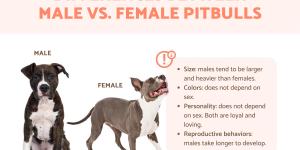Differences between Male and Female Parrots


Sexual dimorphism is not a rule that can be applied to all species of parrots, as in most cases the differences between males and females cannot be seen at first glance. The only possible way to distinguish them is through analysis or by consulting an expert.
However, in certain species of parrots and parakeets the differences between males and females are obvious. If you keep reading this AnimalWised article, we'll show you some species with clear differences between male and female parrots.
Sexual dimorphism in cockatiels
Sexual dimorphism does exist in some cockatoo species like the cockatiel (Nymphicus hollandicus). The difference between male and female cockatiels is that underneath the tail of the female there are dark markings like stripes, while in males this area has one solid color.
In normal grey cockatiels, facial differences between females and males are also present. The patches on the females' cheeks are softer and lighter-colored, while male cockatiels have more intense colours in these areas of the face.
In pearled cockatiels, if after the first molting they retain the pearls on their wings, they are female. Males lose these characteristic patterns after molting.
In white-faced cockatiels, males have white faces. Females, however, usually have gray faces; even when they're white, you can still tell them apart because their head tends to be smaller than that of males.

Sexual dimorphism in eclectus parrots
In the ecletus parrot (Eclectus roratus) the difference between male and female is extreme.
Males are deep green in color, and their beaks are a yellowish orange. Females, on the other hand, are a beautiful combination of red and blue and they have a black beak.

Sexual dimorphism in budgerigars
Sexual dimorphism among budgerigars (Melopsittacus undulatus) can be seen in the cere. The cere is the nose, that is, the fleshy area where the bird's beak begins.
The cere in most males is dark blue. If the male is albino or lutino, their cere is pink or violet. Females have a light blue cere, which turns brown when they come into mating season. Young budgies, both male and female, have white ceres.
Another Australian parrot, the scarlet-chested or splendid parrot (Neophema splendida), also presents clear sexual dimorphism. Females do not have the scarlet fringe that males have on their chests.
Here you can learn more about the differences between male and female budgerigars.

Sexual dimorphism in rose-ringed parakeets
There are different subspecies of rose-ringed or ring-necket parakeet (Psittacula krameri). Sexual dimorphism is clear in all, because males have a kind of distinctive red or black necklace and the females do not.
This species needs daily handling and constant enrichment in terns of their environment and activities; otherwise they can suffer from severe stress. They can understand up to 250 different words, and perhaps this is why a lack of stimulation is so damaging to the species.

White-fronted anazib
White-fronted amazons or parrots (Amazona albifrons) have an area on their wings which helps to distinguish between males and females. This area is called the alula and it appears on the front wing joint - where our shoulders would be.
Male white-fronted parrots can be distinguished from females because their alula has bright red feathers. This is something that female either do not have, or they do but it's barely visible.

Other Australian parrots
In Australia there is a wide variety of parrots, each one even more beautiful than the one before. The differences between males and females in some species are clear. Here are some other species with noticeable sexual dimorphism.
- Superb parrots (Polytelis swainsonii): In this species, males have red and yellow colors on their face and throat, whereas females do not.
- Australian king parrots (Alisterus scapularis): Females have a green face, head and throat, whereas in males these areas are red. Young Australian king parrots do not acquire their definitive colors until the age of three.

Other ways of distinguishing between male and female parrots
Most parrot species are not sexually dimorphic, except for those shown above. Distinguishing between the sexes can be tricky if you are not accustomed to the particular species, so many people turn to parrot experts and vets to find out the sex of their bird.
Males can be identified through probing, as they have a lump in the pelvic area, while in females this area is flat. Another method frequently used is DNA testing, although this can be expensive. If your parrot lays an egg, this will clearly reveal that the bird is female.
Finally, we recommend that you don't try and guess the sex of your parrot through its personality because this can vary a lot - and it has nothing to do with human stereotypes about gender. If you want to choose a name for your parrot, take a look at our compilation of 50 unique names for parrots.

Want to learn more about birds and the rest of the animal kingdom? Take a look at the following article on how to tell a male from a female goldfinch.
If you want to read similar articles to Differences between Male and Female Parrots, we recommend you visit our Comparisons category.







 how to tell male /female in kakariki birds
how to tell male /female in kakariki birds







